Naozumi Miyabe1, Noel Barüt2 and S. Chow1
1 National Research Institute of Far Seas FisheriesABSTRACT
5-7-1 Orido
Shimizu, Shizuoka 424 Japan2 Bureau of Fisheries and Aquatic Resources
860 Quezon Avenue
Quezon City 1100 Philippines
The species identifications of small juvenile bigeye and yellowfin tunas, once made by field samplers working on tuna surface fisheries in the Philippines, were re-examined by mtDNA analysis. A total of 513 tunas between 150 and 400 mm fork length were collected and re-examined; 502 (97.9%) were analysed and eight (1.6 %) were misidentified. This indicates that species identification by samplers is, in general, accurate. The magnitude of the bigeye catch is likely to be much smaller than that of yellowfin, as indicated in the results of the sampling program.
1. INTRODUCTION
The Philippines tuna fisheries are characterized by a wide variety of artisanal fisheries and a large quantity of very small-sized tunas caught (200-300 mm fork length, FL). There is probably no other country catching such a significant amount of small tunas. Recent FAO catch statistics show nearly 80,000 mt of yellowfin tuna and 100,000 mt of skipjack tuna caught. Despite the fact that bigeye tuna are caught by the fisheries in the Philippines, no catch of bigeye has been reported in the FAO statistics or the Philippines national statistics, since bigeye catches are combined with those of yellowfin. This is probably reflecting the facts that the amount of bigeye catch is much smaller than yellowfin and there is no price difference paid at market for small fish of these two species.
To create more reliable catch and effort statistics and to facilitate tuna research, the Philippines Bureau of Fisheries and Aquatic Resources (BFAR), with the assistance of other international organizations such as South China Sea Fisheries Programme, Indo-Pacific Tuna Programme (IPTP) and South Pacific Commission (SPC), have conducted sampling surveys at several vessel off-loading sites in Philippines since 1979. While bigeye catches were reported in most of the sampling sites by some gears, e.g., purse seine and handline (Barüt and Arce, 1991; Morón, 1993; SPC, 1994), the estimated total catch for bigeye was not given.
The reliability of this sampling, however, is somewhat questionable because the catch of bigeye was not consistent, even in the same sampling site and by the same fishing gear, while the catches of yellowfin and skipjack were relatively constant and at a high level. As it is known that skipjack, yellowfin and bigeye are caught together by the same fishing gear such as purse seine, a similar proportional catch is expected for bigeye. This inconsistency may be caused by species identification problem because yellowfin and bigeye tunas are morphologically very similar especially when they are young.
The main objective of this study is to check the accuracy of species identification in Philippines samples, especially between yellowfin and bigeye tunas, through genetic analyses and, if possible, to develop easy keys to separate these species based on the external characters. The results of this analysis can be very beneficial for the stock analysis of both tunas, since the catch in number could be quite large even if the catch in weight is relatively small.
2. FIELD SAMPLING
2.1 Methods.
From April 1993 to February 1994, four field samplings were made in four major vessel off-loading sites in the Philippines. The first one took place in April and three more samplings were made in July, September and February. The sampling sites were General Santos in Mindanao (Celebes Sea), Puerto Princessa In Palawan (Sulu Sea), Masinloc in Luzon (South China Sea) and Atimonan in Luzon (Pacific). These locations are shown in Figure 1. These sampling sites were selected to consider the magnitude and modes of fishing operations, and to cover as wide an area as possible.
The sampling scheme was to collect yellowfin and bigeye tunas of 150-350 mm FL, randomly selecting five fish in every 50 mm length interval, at each sampling site and time. Accordingly, the total number of fish sampled would be 320 fishes for each sampling. In this way, it was expected that there would be enough fish to estimate the ratio of species misidentifications by samplers, if it existed. In addition, the sample should be large enough to characterise any changes in morphological characters by size and by season.
Field identification of tuna species was mostly made by the field samplers hired by BFAR in the same manner as they do in the normal sampling, except in Atimonan where the authors made species identification. All the sampling was accompanied by N. Barüt. N. Miyabe and S. Chow joined the first and the third sampling, respectively. These samplers and authors who participated in the sampling spent several days at each sampling site waiting for the off-loading of small tunas. Most of small tunas came from ring nets, purse seines and handlining. After each fish was identified, the fork length and body weight were measured with calipers and a scale, respectively, and a small amount of tissue sample (a few grams) was taken. The fish and tissue samples were preserved in formalin and ethanol, respectively, within few hours after the sampling and later transported to the National Research Institute for Far Seas Fisheries (NRIFSF) in Shimizu. Samples in formalin were further sent to I. Nakamura, Kyoto University, for subsequent morphological analysis.
Figure 1. Areas of juvenile tuna sampling in Philippines.
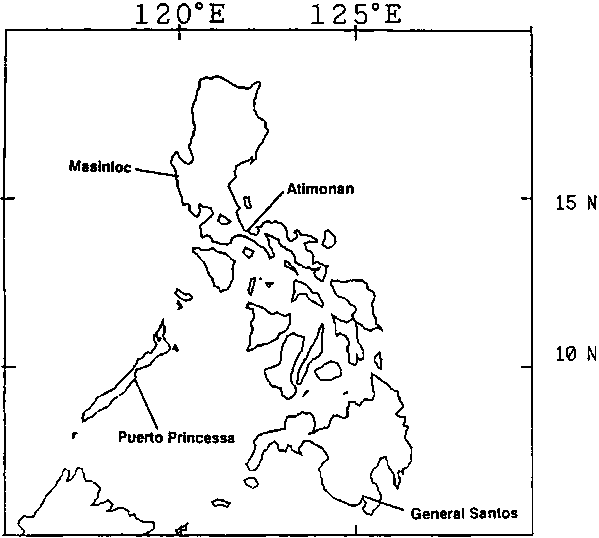
2.2 Results of Data Collection.
A total of 513 tunas were collected and identified based on external characteristics--395 yellowfin and 118 bigeye. This is only about 40% of the expected sample size. Table 1 shows the number of fish by sampling location and species. The only site where sampling was done satisfactorily was General Santos. At Masinloc and Atimonan, complete sampling was not successful except for yellowfin at the third sampling. The sampling of yellowfin was almost complete in Puerto Princessa, but not enough bigeye were sampled as scheduled.
There are several reasons for the incomplete sampling. One is that the duration of the sampling period was not long enough. Occasionally, landings of small tunas were made a few days before we arrived. Another reason is that fishing operations by ring net or small-scale purse seine, which catch small tunas in substantial quantities, was seasonal, and no operations were conducted during the sampling periods. This is true, in part, at Atimonan, where purse seiners and ring netters operate seasonally.
Table 1. Number of fish collected by field sampling in Philippines. Figures in bracket show the number of misidentified fish.
|
|
1st Sampling |
2nd Sampling |
3rd Sampling |
4th Sampling |
|||||
|
Period |
14-19 Apr |
24 Jul - 2 Aug |
21 Sep - 31 Oct |
8 Jan - 4 Feb |
|||||
|
Place |
Species |
YFT |
BET |
YFT |
BET |
YFT |
BET |
YFT |
BET |
|
General Santos |
36 |
36 |
54 |
47 |
46 |
18 |
42 |
8 |
|
|
Puerto Princessa |
12* |
0 |
42 |
4 |
40(2) |
0 |
26(1) |
0 |
|
|
Masinloc |
0 |
0 |
0 |
0 |
32(1)** |
5(3) |
5(1) |
0 |
|
|
Atimonan |
0 |
0 |
0 |
0 |
60 |
0 |
0 |
0 |
|
|
Total |
48 |
36 |
96 |
51 |
178 |
23 |
73 |
8 |
|
YFT total = 395, BET total = 118, Grand total = 513The length frequency distributions of sampled fish are shown in Figures 2-6, by sampling site and season. Fish smaller than 200 mm FL are relatively scarce. Reflecting the sampling scheme, samples are scattered more or less evenly between 200 and 400 mm. When the desired sampling scheme could not be met due to shortage of tuna catch or absence of required fish size, fish from other length classes were sampled to reach the expected sample number, and in some cases larger-sized fish up to 400 mm were included.
Numbers used for mtDNA (YFT=384, BET=118, total=502)
* 2 yellowfin failed to be amplified mtDNA
** 9 yellowfin failed to be amplified mtDNA
Species identification using external characters such as marks and bands (Figure 7) on the lateral part of body, the diameter of eye orbit, length of pectoral fin and body depth seems relatively easy for a well-trained sampler when fish are fresh, but it is difficult to separate bigeye from yellowfin when those characters are not clear after storage on ice or when the fish is damaged. Skipjack tuna is simple to identify because it has clear banding on the side of the body and a rather elongated body. Bigeye and yellowfin are easily separated from skipjack, for fish bigger than 200 mm, since the former have elongated pectoral fins.
Unfortunately, for small tunas, the morphological analysis of yellowfin and bigeye to develop easy keys for the species identification has not been completed. The results will be reported soon after the analysis is completed.
3. SPECIES IDENTIFICATION USING mtDNA
Once morphologically identified and sampled, bigeye and yellowfin tunas were re-examined by mitochondrial DNA (mtDNA) analysis. The procedure for DNA extraction, optimal condition for amplifying mitochondrial ATPase gene, and the diagnostic restriction profiles between species of Thunnus are described in Chow et al. (1993) and Chow and Inoue (1993). Since bigeye tuna has been reported to represent distinct restriction profiles from the yellowfin tuna by the restriction endonucleases Mse I and Rsa I, one of these restriction endonucleases were used in this study. Representative differences in the restriction profiles between the yellowfin and bigeye tunas are shown in Figures 8 and 9. Mitochondrial ATPase gene fragments of 384 individuals of designated yellowfin tuna were successfully amplified, and the restriction analysis indicated five specimens to have bigeye-type mtDNA. All 118 designated bigeye tuna were successfully amplified, of which three possessed yellowfin-type mtDNA (Table 1).
Figure 2. Length frequency of sampled yellowfin in General Santos (GS) and Puerto Princessa (PP).
YFT, GS, 1st

YFT, GS, 2nd
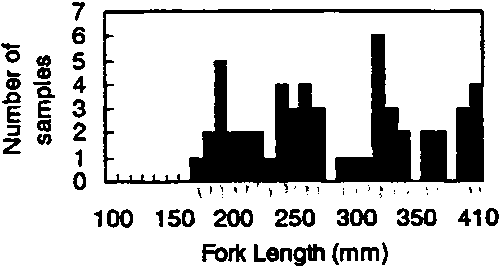
YFT, GS, 3rd
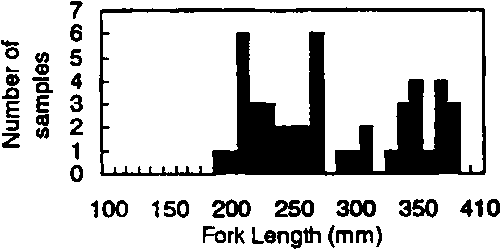
YFT, GS, 4th
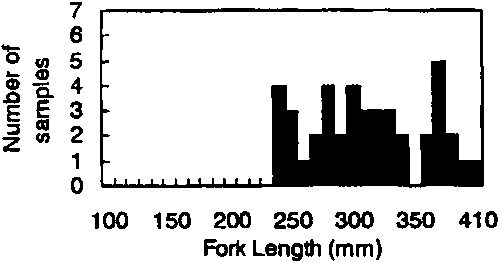
YFT, PP, 1st
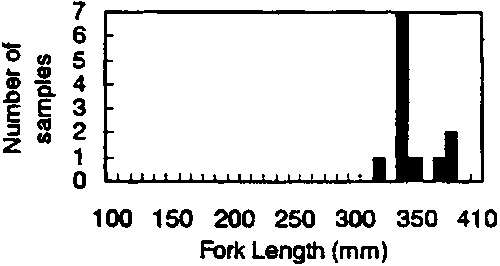
YFT, PP, 2nd

YFT, PP, 3rd
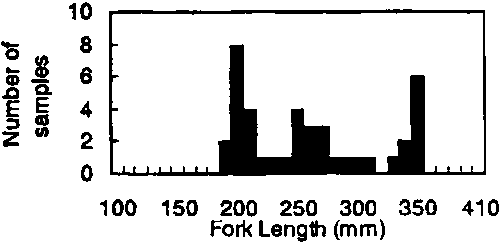
YFT, PP, 4th
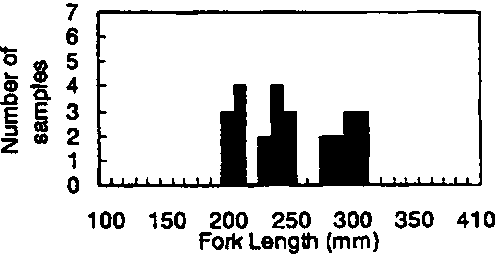
Figure 3. Length frequency of sampled yellowfin in Masinloc (MA) and Atimonan (AT).
YFT, MA, 3rd
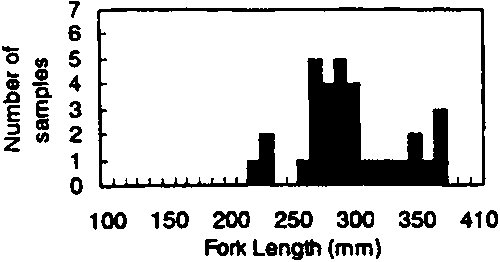
YFT, AT, 3rd
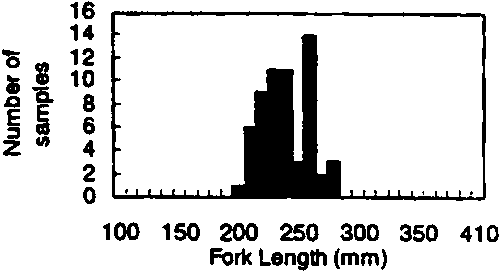
Figure 4. Total length frequency of sampled yellowfin in Philippines.
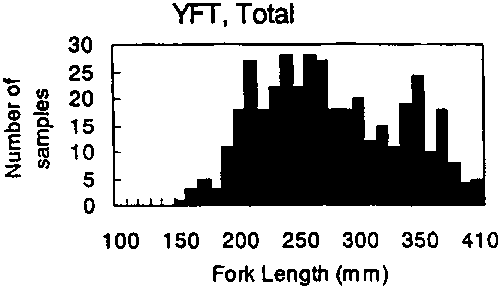
Figure 5. Length frequency of sampled bigeye in General Santos (GS).
BET, GS, 1st
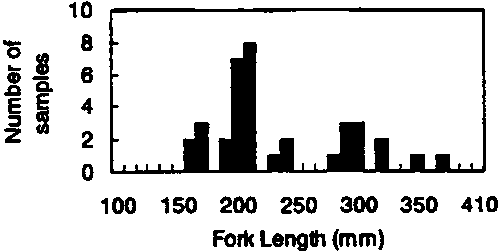
BET, GS, 2nd

BET, GS, 3rd

BET, GS, 4th

Figure 6. Total length frequency of sampled bigeye in Philippines.

4. DISCUSSION
According to the mtDNA analysis, eight (1.6 %) of 502 tunas were misidentified. Five (1.3 %) were misidentified as yellowfin and three (2.5 %) as bigeye. It is interesting to note that wrong identifications were observed in only two sampling sites when the sample size was incomplete. The misidentification rate for the two species combined was 2.5% in Puerto Princessa and 12.1% in Masinloc. This may indicate that samplers in those places were less experienced. Nonetheless, the results of mtDNA analysis indicate that species identification by samplers is generally accurate and usable. As indicated in the results of sampling program, the magnitude of bigeye catch is likely to be much smaller than that of yellowfin.
Figure 7. Lateral marks and bands of bigeye and yellowfin tunas (after Honma et al., 1973).
BIGEYE TUNA
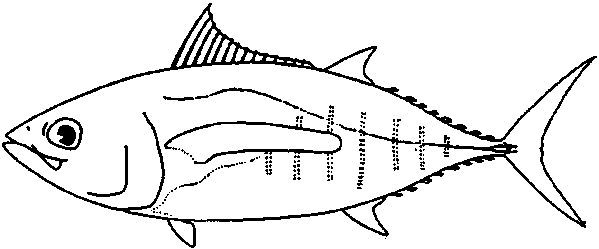
YELLOWFIN TUNA
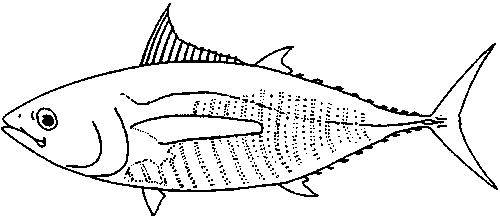
Figure 8. Restriction profile of mitochondrial ATPase gene fragments digested by Mse I endonuclease, showing clear differences between yellowfin and bigeye tunas.
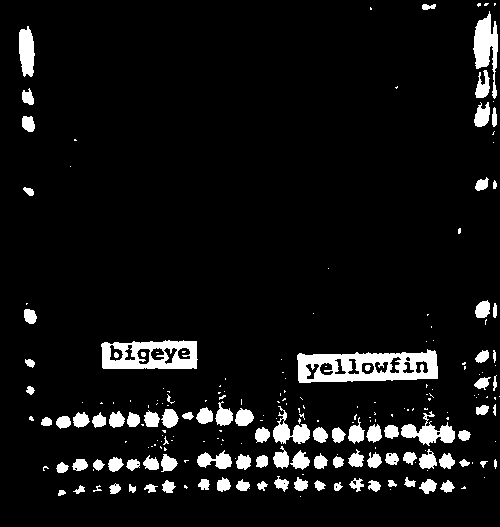
Figure 9. Restriction profile of mitochondrial ATPase gene fragments digested by Rsa I endonuclease, showing clear differences between yellowfin and bigeye tunas.

5. REFERENCES CITED
Barüt, N.C., and F.M. Arce. 1991. The Philippines tuna fisheries: Industry and Research. Coll. Vol. Work. Doc. Fourth Southeast Asian Tuna Conf. Indo-Pacific Tuna Programme: 12-42.
Chow, S., P.J. Walsh and M.E. Clarke. 1993. PCR-RFLP analysis on thirteen western Atlantic snappers (subfamily Lutjaninae): a simple method for species and stock identification. Fish. Bull. 91: 619-627.
Chow, S., and S. Inoue. 1993. Intra- and interspecific restriction fragment length polymorphisms in mitochondrial genes of Thunnus tuna species. Bull. Natl. Res. Inst. Far Seas Fish. 30: 207-225.
Honma, M., Y. Warashina and Z. Suzuki, 1973. Identification of young yellowfin and bigeye tunas in the western Pacific Ocean. Examination of practical standards based on external characters and the reliability in field survey. Bull. Far Seas Res. Lab. 8: 1-23.
Morón, J. 1993. The tuna sampling programme in the Philippines. Coll. Vol. Work. Doc. Fifth Southeast Asian Tuna Conf. Indo-Pacific Tuna Programme 7: 53-75.
South Pacific Commission (SPC). 1994. Oceanic Fisheries Programme: Work programme review 1993-1994 and work plan 1994-95. Seventh Standing Committee on Tuna and Billfish. South Pacific Commission Working Paper 5: 66 p.